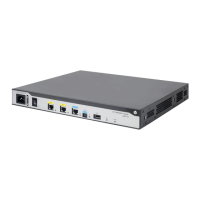264
Configuring the DHCPv6 client
Overview
With DHCPv6 client configured, an interface can obtain configuration parameters from the DHCPv6
server.
A DHCPv6 client can use DHCPv6 to complete the following functions:
• Obtain an IPv6 address, an IPv6 prefix, or both, and obtain other configuration parameters. The
client automatically creates a DHCPv6 option group for the obtained parameters. With the
obtained IPv6 prefix, the client can generate its global unicast address.
• Support stateless DHCPv6 to obtain configuration parameters except IPv6 address and IPv6
prefix. The client obtains an IPv6 address through stateless IPv6 address autoconfiguration. If
the client receives an RA message with the M flag set to 0 and the O flag set to 1 during address
acquisition, stateless DHCPv6 starts.
Configuration restrictions and guidelines
When you configure DHCPv6 client, follow these restrictions and guidelines:
• The DHCPv6 client configuration is supported only on Layer 3 Ethernet interfaces, Layer 3
Ethernet subinterfaces, Layer 3 aggregate interfaces, Layer 3 aggregate subinterfaces, and
VLAN interfaces.
• Do not configure the DHCPv6 client on the same interface as the DHCPv6 server or the
DHCPv6 relay agent.
DHCPv6 client configuration task list
Tasks at a glance
(Required.) Perform one of the following tasks:
• Configuring IPv6 address acquisition
• Configuring IPv6 prefix acquisition
• Configuring IPv6 address and prefix acquisition
• Configuring stateless DHCPv6
(Optional.) Setting the DSCP value for DHCPv6 packets sent by the DHCPv6 client
Configuring IPv6 address acquisition
Step Command Remarks
1. Enter system view.
system-view
N/A
2. Enter interface view.
interface
interface-type
interface-number
N/A
3. Configure the interface to
use DHCPv6 to obtain an
IPv6 address and other
configuration parameters.
ipv6 address dhcp-alloc
[
option-group
group-number |
rapid-commit
] *
By default, the interface does not
use DHCPv6 for IPv6 address
acquisition.

